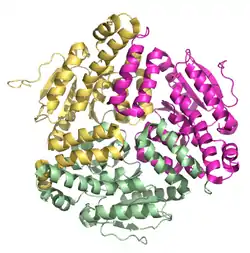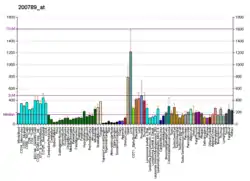| ECH1 | |||||||||||||||||||||||||||||||||||||||||||||||||||
|---|---|---|---|---|---|---|---|---|---|---|---|---|---|---|---|---|---|---|---|---|---|---|---|---|---|---|---|---|---|---|---|---|---|---|---|---|---|---|---|---|---|---|---|---|---|---|---|---|---|---|---|
 | |||||||||||||||||||||||||||||||||||||||||||||||||||
| |||||||||||||||||||||||||||||||||||||||||||||||||||
| Identifiers | |||||||||||||||||||||||||||||||||||||||||||||||||||
| Aliases | ECH1, HPXEL, enoyl-CoA hydratase 1, peroxisomal, enoyl-CoA hydratase 1 | ||||||||||||||||||||||||||||||||||||||||||||||||||
| External IDs | OMIM: 600696 MGI: 1858208 HomoloGene: 1069 GeneCards: ECH1 | ||||||||||||||||||||||||||||||||||||||||||||||||||
| |||||||||||||||||||||||||||||||||||||||||||||||||||
| |||||||||||||||||||||||||||||||||||||||||||||||||||
| |||||||||||||||||||||||||||||||||||||||||||||||||||
| |||||||||||||||||||||||||||||||||||||||||||||||||||
| |||||||||||||||||||||||||||||||||||||||||||||||||||
| Wikidata | |||||||||||||||||||||||||||||||||||||||||||||||||||
| |||||||||||||||||||||||||||||||||||||||||||||||||||
Delta(3,5)-Delta(2,4)-dienoyl-CoA isomerase, mitochondrial is an enzyme that in humans is encoded by the ECH1 gene.[5][6]
This gene encodes a member of the hydratase/isomerase superfamily. The gene product shows high sequence similarity to enoyl-CoA hydratases of several species, particularly within a conserved domain characteristic of these proteins. The encoded protein, Δ3,5-Δ2,4-dienoyl-CoA isomerase, contains a C-terminal peroxisomal targeting sequence and localizes to peroxisomes. The rat ortholog, which localizes to the matrix of both the peroxisome and mitochondria, can isomerize 3-trans,5-cis-dienoyl-CoA to 2-trans,4-trans-dienoyl-CoA, indicating that it is a delta3,5-delta2,4-dienoyl-CoA isomerase. This enzyme functions in the auxiliary step of the fatty acid beta-oxidation pathway. Expression of the rat gene is induced by peroxisome proliferators.[6]
References
- 1 2 3 ENSG00000282853 GRCh38: Ensembl release 89: ENSG00000104823, ENSG00000282853 - Ensembl, May 2017
- 1 2 3 GRCm38: Ensembl release 89: ENSMUSG00000053898 - Ensembl, May 2017
- ↑ "Human PubMed Reference:". National Center for Biotechnology Information, U.S. National Library of Medicine.
- ↑ "Mouse PubMed Reference:". National Center for Biotechnology Information, U.S. National Library of Medicine.
- ↑ FitzPatrick DR, Germain-Lee E, Valle D (Nov 1995). "Isolation and characterization of rat and human cDNAs encoding a novel putative peroxisomal enoyl-CoA hydratase". Genomics. 27 (3): 457–66. doi:10.1006/geno.1995.1077. PMID 7558027.
- 1 2 "Entrez Gene: ECH1 enoyl Coenzyme A hydratase 1, peroxisomal".
Further reading
- Olsen JV, Blagoev B, Gnad F, et al. (2006). "Global, in vivo, and site-specific phosphorylation dynamics in signaling networks". Cell. 127 (3): 635–48. doi:10.1016/j.cell.2006.09.026. PMID 17081983. S2CID 7827573.
- Kovalyov LI, Kovalyova MA, Kovalyov PL, et al. (2006). "Polymorphism of delta3,5-delta2,4-dienoyl-coenzyme A isomerase (the ECH1 gene product protein) in human striated muscle tissue". Biochemistry Mosc. 71 (4): 448–53. doi:10.1134/S0006297906040146. PMID 16615866. S2CID 11794020.
- Gerhard DS, Wagner L, Feingold EA, et al. (2004). "The status, quality, and expansion of the NIH full-length cDNA project: the Mammalian Gene Collection (MGC)". Genome Res. 14 (10B): 2121–7. doi:10.1101/gr.2596504. PMC 528928. PMID 15489334.
- Goehler H, Lalowski M, Stelzl U, et al. (2004). "A protein interaction network links GIT1, an enhancer of huntingtin aggregation, to Huntington's disease". Mol. Cell. 15 (6): 853–65. doi:10.1016/j.molcel.2004.09.016. PMID 15383276.
- Jia Y, Qi C, Zhang Z, et al. (2004). "Overexpression of peroxisome proliferator-activated receptor-alpha (PPARalpha)-regulated genes in liver in the absence of peroxisome proliferation in mice deficient in both L- and D-forms of enoyl-CoA hydratase/dehydrogenase enzymes of peroxisomal beta-oxidation system". J. Biol. Chem. 278 (47): 47232–9. doi:10.1074/jbc.M306363200. PMID 14500732.
- Strausberg RL, Feingold EA, Grouse LH, et al. (2003). "Generation and initial analysis of more than 15,000 full-length human and mouse cDNA sequences". Proc. Natl. Acad. Sci. U.S.A. 99 (26): 16899–903. Bibcode:2002PNAS...9916899M. doi:10.1073/pnas.242603899. PMC 139241. PMID 12477932.
- Filppula SA, Yagi AI, Kilpeläinen SH, et al. (1998). "Delta3,5-delta2,4-dienoyl-CoA isomerase from rat liver. Molecular characterization". J. Biol. Chem. 273 (1): 349–55. doi:10.1074/jbc.273.1.349. PMID 9417087.
External links
- Overview of all the structural information available in the PDB for UniProt: Q13011 (Delta(3,5)-Delta(2,4)-dienoyl-CoA isomerase, mitochondrial) at the PDBe-KB.




